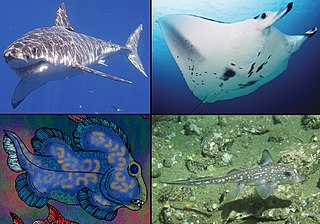
Chondrichthyes is a class of jawed fish that contains the cartilaginous fish or chondrichthyans, which all have skeletons primarily composed of cartilage. They can be contrasted with the Osteichthyes or bony fish, which have skeletons primarily composed of bone tissue. Chondrichthyes are aquatic vertebrates with paired fins, paired nares, placoid scales, conus arteriosus in the heart, and a lack of opercula and swim bladders. Within the infraphylum Gnathostomata, cartilaginous fishes are distinct from all other jawed vertebrates.
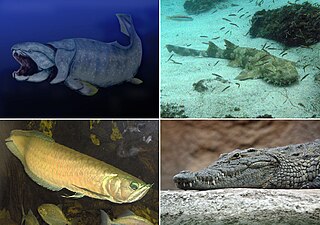
Gnathostomata are the jawed vertebrates. Gnathostome diversity comprises roughly 60,000 species, which accounts for 99% of all living vertebrates, including humans. Most gnathostomes have retained ancestral traits like true teeth, a stomach, and paired appendages. Other traits are elastin, a horizontal semicircular canal of the inner ear, myelin sheaths of neurons, and an adaptive immune system which has discrete lymphoid organs, and uses V(D)J recombination to create antigen recognition sites, rather than using genetic recombination in the variable lymphocyte receptor gene.
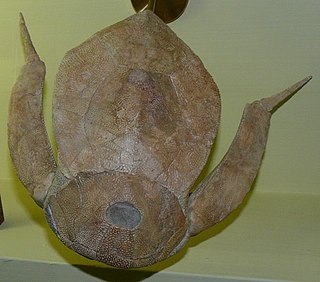
Placoderms are vertebrate animals of the class Placodermi, an extinct group of prehistoric fish known from Paleozoic fossils during the Silurian and the Devonian periods. While their endoskeletons are mainly cartilaginous, their head and thorax were covered by articulated armoured plates, and the rest of the body was scaled or naked depending on the species.

Dunkleosteus is an extinct genus of large arthrodire ("jointed-neck") fish that existed during the Late Devonian period, about 382–358 million years ago. It was a pelagic fish inhabiting open waters, and one of the first apex predators of any ecosystem.

Arthrodira is an order of extinct armored, jawed fishes of the class Placodermi that flourished in the Devonian period before their sudden extinction, surviving for about 50 million years and penetrating most marine ecological niches. Arthrodires were the largest and most diverse of all groups of placoderms.
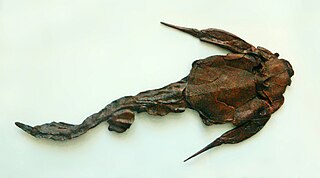
Bothriolepis was a widespread, abundant and diverse genus of antiarch placoderms that lived during the Middle to Late Devonian period of the Paleozoic Era. Historically, Bothriolepis resided in an array of paleo-environments spread across every paleocontinent, including near shore marine and freshwater settings. Most species of Bothriolepis were characterized as relatively small, benthic, freshwater detritivores, averaging around 30 centimetres (12 in) in length. However, the largest species, B. rex, had an estimated bodylength of 170 centimetres (67 in). Although expansive with over 60 species found worldwide, comparatively Bothriolepis is not unusually more diverse than most modern bottom dwelling species around today.

Coccosteus is an extinct genus of arthrodire placoderm from the Devonian period. Its fossils have been found throughout Europe and North America. The majority of these have been found in freshwater sediments, though such a large range suggests that they may have been able to enter saltwater. It was a small placoderm, with Coccosteus cuspidatus measuring 29.6–39.4 cm (11.7–15.5 in) long.

Rhenanida is an order of scaly placoderms. Unlike most other placoderms, the rhenanids' armor was made up of a mosaic of unfused scales and tubercles. The patterns and components of this "mosaic" correspond to the plates of armor in other, more advanced placoderms, suggesting that the ancestral placoderm had armor made of unfused components, as well.
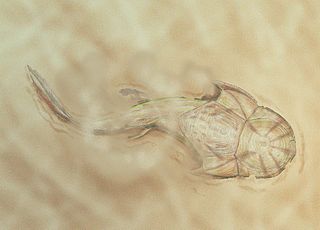
Phyllolepis is the type genus of Phyllolepida, an extinct taxon of arthrodire placoderm fish from the middle to late Devonian. The species of Phyllolepis, themselves, are restricted to the Famennian-aged freshwater strata of the Late Devonian, around 360 million years ago. Fossils of this genus have been found primarily in Europe and North America. The end of the Devonian saw them disappear in a mass extinction.
The Xitun Formation is a palaeontological formation which is named after Xitun village in Qujing, a location in South China. This formation includes many remains of fossilized fish and plants of the Early Devonian period. It was originally referred to as the Xitun Member of the Cuifengshan Formation.
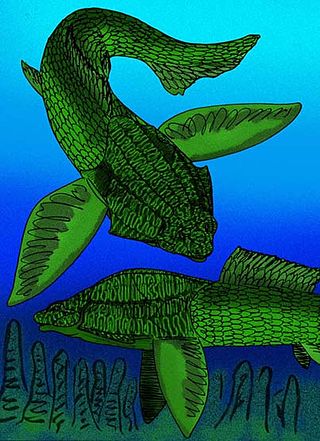
Holonema is an extinct genus of relatively large, barrel-shaped arthrodire placoderms that were found in oceans throughout the world from the Mid to Late Devonian, when the last species perished in the Frasnian-Fammian extinction event. Most species of the genus are known from fragments of their armor, but the Gogo Reef species, H. westolli, is known from whole, articulated specimens.
Guiyu oneiros is one of the earliest articulated bony fish discovered. Fossils of Guiyu have been found in what is now Qujing, Yunnan, China, in late Silurian marine strata, about 425 million years old.
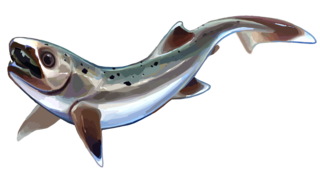
Mcnamaraspis is an extinct monospecific genus of arthrodire placoderm that inhabited the ancient reef system of north Western Australia during the Frasnian epoch of the Late Devonian period. The type specimen was found and described by John A. Long from the Gogo Formation near Fitzroy Crossing. This fossil fish showed new anatomical features in arthrodires, like the well-preserved annular (ring-shaped) cartilages of the snout, previously inferred to be present by Erik Stensiö of Sweden. It is occasionally referred to as "The Gogo Fish" after the locale the holotype was excavated from.
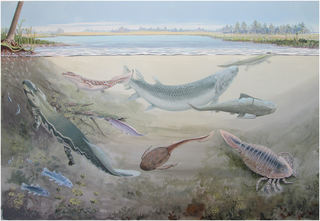
The evolution of fish began about 530 million years ago during the Cambrian explosion. It was during this time that the early chordates developed the skull and the vertebral column, leading to the first craniates and vertebrates. The first fish lineages belong to the Agnatha, or jawless fish. Early examples include Haikouichthys. During the late Cambrian, eel-like jawless fish called the conodonts, and small mostly armoured fish known as ostracoderms, first appeared. Most jawless fish are now extinct; but the extant lampreys may approximate ancient pre-jawed fish. Lampreys belong to the Cyclostomata, which includes the extant hagfish, and this group may have split early on from other agnathans.

Entelognathus primordialis is an early placoderm from the late Silurian of Qujing, Yunnan, 419 million years ago.
Microbrachius is an extinct genus of tiny, advanced antiarch placoderms closely related to the bothriolepids. Specimens range in age from the Lower Devonian Late Emsian Stage to the Middle Devonian Upper Givetian Stage. They are characterized by having large heads with short thoracic armor of an average length of 2–4 cm. There are patterns of small, but noticeable tubercles on the armor, with the arrangement varying from species to species. Specimens of Microbrachius have been found in Scotland, Belarus, Estonia, and China.
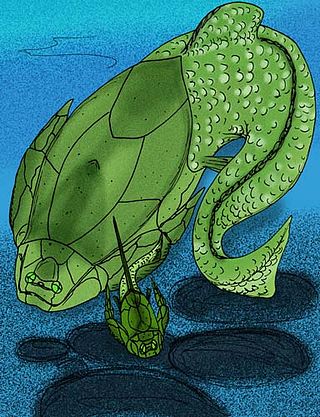
Asterolepis is an extinct genus of antiarch placoderms from the Devonian of North and South America and Europe. They were heavily armored flat-headed benthic detritivores with distinctive jointed limb-like pectoral fins and hollow spine. The armor plate gives the Asterolepis a box-like shape. Its pectoral fins are also armored but the caudal and dorsal fin are not. The first fossils were named by M. Eichwald in 1840 after noticing star-like markings on the fossils.
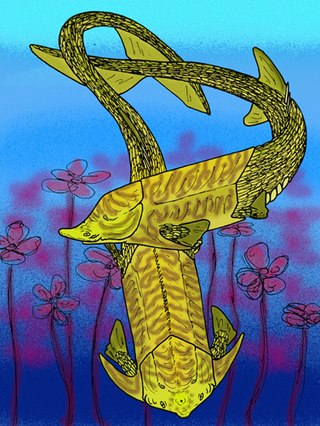
Qilinyu is a genus of early placoderm from the late Silurian of China. It contains a single species, Qilinyu rostrata, from the Xiaoxiang fauna of the Kuanti Formation. Along with its contemporary Entelognathus, Qilinyu is an unusual placoderm showing some traits more similar to bony fish, such as dermal jaw bones and lobe-like fins. It can be characterized by adaptations for a benthic lifestyle, with the mouth and nostrils on the underside of the head, similar to the unrelated antiarch placoderms. The shape of the skull has been described as "dolphin-like", with a domed cranium and a short projecting rostrum.

The Mandagery Sandstone is a Late Devonian geological formation in New South Wales, Australia. It is one of several famed Australian lagerstätten, with thousands of exceptional fish fossils found at a site near the town of Canowindra.





















